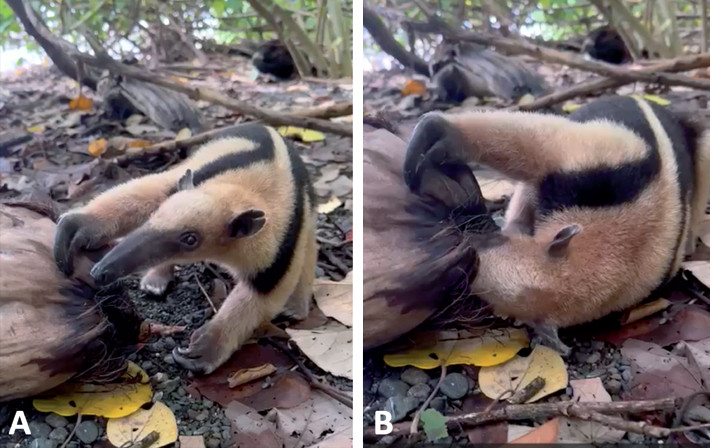Use of coconuts (Cocos nucifera: Arecaceae) as nutrient source by Northern Tamandua (Tamandua mexicana: Myrmecophagidae)
DOI:
https://doi.org/10.31687/SaremNMS23.10.5Keywords:
anteaters, coconut palm tree, Corcovado National Park, Costa Rica, fruitsAbstract
Northern Tamandua relies on a diet primarily composed of eusocial insects. We have observed this species interacting with coconuts on the ground at Corcovado National Park, Costa Rica. The tamandua inserts its snout into the coconuts and apparently drinks their contents. Occasionally we have observed the tamandua holding the coconut, using its largest claws to open it from the side and consuming from the inside. However, besides potential drinking, it was not possible to determine precisely what else it ate, if anything. Coconut water serves as a source of essential elements, including iron and selenium, from which tamanduas may benefit.
References
Alchoubassi, G., K. Kińska , K. Bierla, R. Lobinski, & J. Szpunar. 2021. Speciation of essential nutrient trace elements in coconut water. Food Chemistry 339:127680. https://doi.org/10.1016/j.foodchem.2020.127680.
Appaiah, P., L. Sunil, P. P. Kumar, & A. G. Krishna. 2015. Physico-chemical characteristics and stability aspects of coconut water and kernel at different stages of maturity. Journal of Food Science and Technology 52:5196–5203. https://doi.org/10.1007/s13197-014-1559-4.
Baudouin, L., & P. Lebrun. 2009. Coconut (Cocos nucifera L.) DNA studies support the hypothesis of an ancient Austronesian migration from Southeast Asia to America. Genetic Resources and Crop Evolution 56:257–262. https://doi.org/10.1007/s10722-008-9362-6.
Bertassoni, A. 2018. Family Myrmecophagidae (Anteaters). Handbook of Mammals of the World, Vol. 8: Insectivores, sloths, and colugos (D. E. Wilson & R. A. Mittermeier, eds.). Lynx Edicions, Barcelona.
Brown, D. D. 2011. Fruit-eating by an obligate insectivore: palm fruit consumption in wild northern tamanduas (Tamandua mexicana) in Panama. Edentata 12:63–65. https://doi.org/10.5537/020.012.0110.
Chan, E., & C. R. Elevitch. 2006. Cocos nucifera (coconut). Species profiles for Pacific Island Agroforestry 2:1–27.
Corrêa Vaz, V., R. T. Santori, A. M. Jansen, A. C. Delciellos, & P. S. D'Andrea. 2012. Notes on food habits of armadillos (Cingulata, Dasypodidae) and anteaters (Pilosa, Myrmecophagidae) at Serra da Capivara National Park (Piauí State, Brazil). Edentata 13:84–89. https://doi.org/10.5537/020.013.0107.
Cuarón, A. D. 2014. Mexican anteater. Mammals of Mexico (G. Ceballos, ed.). Johns Hopkins University Press, Baltimore, Maryland.
Foale, M. 2003. Coconut odyssey: the bounteous possibilities of the tree of life. Australian Centre for International Agricultural Research, Canberra.
Foerster, C. R., & C. Vaughan. 2002. Home range, habitat use, and activity of Baird's tapir in Costa Rica. Biotropica 34:423–437. https://doi.org/10.1111/j.1744-7429.2002.tb00556.x.
Grimwood, B. E. 1975. Coconut palm products: their processing in developing countries (No. 99). Food & Agriculture Org., Roma.
Gunn, B. F., Baudouin, L., & K. M. Olsen. 2011. Independent origins of cultivated coconut (Cocos nucifera L.) in the old world tropics. PLOS One 6:e21143. https://doi.org/10.1371/journal.pone.0021143.
Hayssen, V. 2011. Tamandua tetradactyla (Pilosa: Myrmecophagidae). Mammalian Species 43:64–74. https://doi.org/10.1644/875.1.
Kappelle, M. (ed.). 2016. Costa Rican ecosystems. University of Chicago Press, Chicago.
Lima de Paiva Medeiros, V. de F., & A. C. Madeiros. 2012. Therapeutic use of coconut water. Journal of Surgical and Clinical Research 3:83–91. https://doi.org/10.20398/jscr.v3i2.3570.
Lima, E. B., et al. 2015. Cocos nucifera (L.) (Arecaceae): a phytochemical and pharmacological review. Brazilian Journal of Medical and Biological Research 48:953–964. https://doi.org/10.1590/1414-431x20154773.
Lubin, Y. D., & G. G. Montgomery. 1981. Defenses of Nasutitermes termites (Isoptera, Termitidae) against Tamandua anteaters (Edentata, Mynnecophagidae). Biotropica 13:66–76. https://doi.org/10.2307/2387872.
Montgomery, G. G. 1985. Impact of vermilinguas (Cyclopes, Tamandua: Xenarthra = Edentata) on arboreal ant populations. The evolution and ecology of armadillos, sloths, and vermilinguas (G. G. Montgomery, ed.). Smithsonian Institution Press, Washington, D.C.
Montgomery, G. G., & Y. D. Lubin. 1977. Prey influences on movements of Neotropical anteaters. Proceedings of the 1975 Predator Symposium (R. L. Phillips & C. Jonkel, eds.). Montana Forest and Conservation Experiment Station, University of Montana, Missoula.
Mora, J. M. 2000. Mamíferos silvestres de Costa Rica. 1st edition. Editorial Universidad Estatal a Distancia, San José.
Navarrete, D. & J. Ortega. 2011. Tamandua mexicana (Pilosa: Myrmecophagidae). Mammalian Species 43:56–63. https://doi.org/10.1644/874.1.
Patterson, B., et al. 1992. The ear region in Xenarthrans (= Edentata: Mammalia), Part II: Pilosa (sloths, anteaters), palaeanodonts, and a miscellany. Fieldiana: Geology (New Series) 24:1–79. https://doi.org/10.5962/bhl.title.3466.
Perera, L., S. A. C. N. Perera, C. K. Bandaranayake, & H. C. Harries. 2008. Chapter 12: Coconut. Handbook of plant breeding, Vol. 4: oil crops (J. Vollmann & I. Rajcan, eds). Springer, New York. https://doi.org/10.1007/978-0-387-77594-4_12.
Pradeepkumar, T. 2008. Horticulture Science Series, Vol. 11: Management of horticultural crops. New India Publishing, India. https://doi.org/10.59317/9789389130942.
Reid, F. A. 2009. A field guide to the mammals of Central America and Southeast Mexico. 2nd edition. Oxford University Press, Oxford.
Rodrigues, F. H. G., I. M. Medri, G. H. B. De Miranda, C. Camiloalves, & G. Mourao. 2008. Anteater behavior and ecology. The biology of the Xenarthra (S. F. Vizcaíno & W. J. Loughry, eds.). University Press of Florida, Gainesville.
Srivastava, R., & G. Srivastava. 2014. Fossil fruit of Cocos L. (Arecaceae) from Maastrichtian-Danian sediments of central India and its phytogeographical significance. Acta Palaeobotanica 54:67–75. https://doi.org/10.2478/acpa-2014-0003.
van Eijk, P. 2005. The impact of hunting on seed dispersal, survival and seedling recruitment in a tropical palm species. Interactions among agoutis, bruchid beetles and the palm Astrocaryum standleyanum in a Panamanian rainforest. Master's Thesis. Rijksuniversiteit Groningen, Haren.
Willmer, P. 2011. Pollination and floral ecology. Princeton University Press, Princeton.
Yong, J. W., L. Ge, Y. F. Ng, & S. N. Tan. 2009. The chemical composition and biological properties of coconut (Cocos nucifera L.) water. Molecules 14:5144–5164. https://doi.org/10.3390/molecules14125144.
Zulaikhah, S. T. 2019. Health benefits of tender coconut water (TCW). International journal of Pharmaceutical Sciences and Research 10:474–80.

Downloads
Published
How to Cite
Issue
Section
License
Copyright (c) 2023 José Manuel Mora, Dionisio Paniagua

This work is licensed under a Creative Commons Attribution-NonCommercial 4.0 International License.

